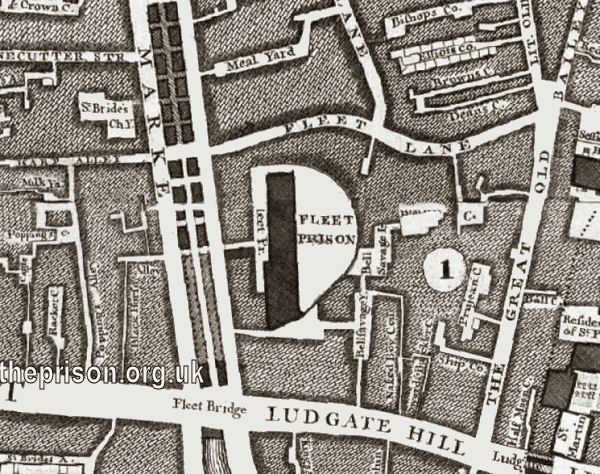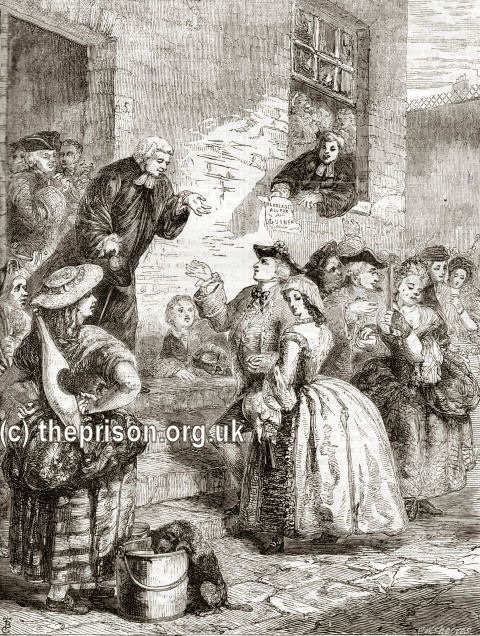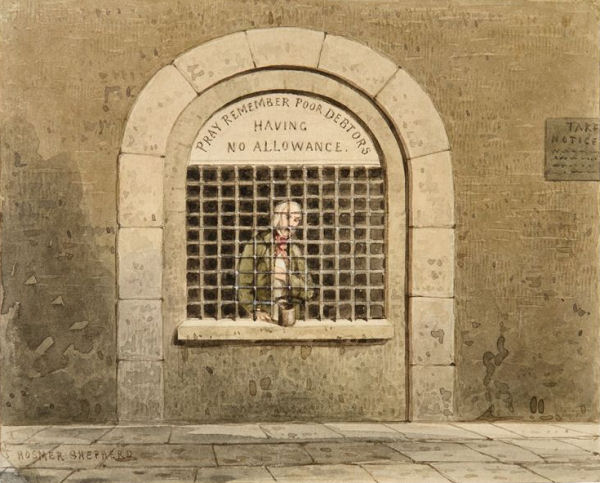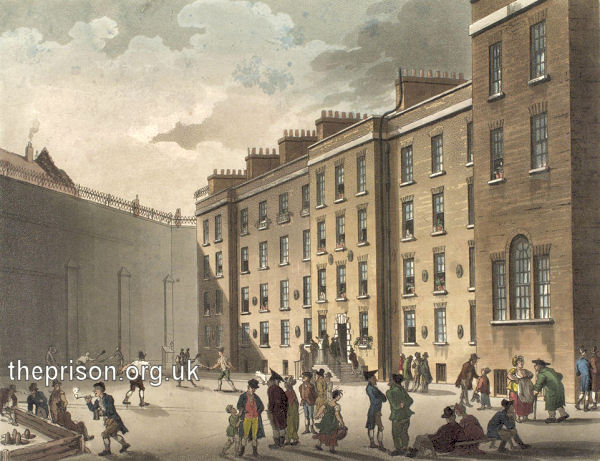Fleet Prison, City of London, London
The Fleet Prison was founded in 1197, on the eastern bank of the River Fleet, off what is now Farringdon Street, and just outside the Ludgate entrance to London. The prison was originally used by the king to hold those charged with offences against the state, including those of the highest rank.
In around 1335, a ten-foot wide moat was built around the prison so that it was entirely surrounded with water. However, the prison's neighbours decided that the moat would make an excellent drain for the waste from their stables, lavatories and sewers. Within twenty years, the moat was in a filthy state, a situation made worse in 1354 when a riverside wharf near the prison was let to some butchers as a place to deposit the entrails of slaughtered cattle. The moat soon became so congested with offal that it was possible to walk across it.
The Fleet was particularly associated with the Star Chamber — a court which sat at the Palace of Westminster from the late 15th century to the mid-17th century. The court was originally established to ensure the fair enforcement of laws against powerful and prominent who the ordinary courts might hesitate to convict. However, it became synonymous with social and political oppression through the arbitrary use and abuse of its power.
The prison was destroyed and rebuilt several times. In 1381, during the Peasants' Revolt, it was destroyed by Wat Tyler's men. In 1666, it was burned down during the Great Fire of London, with the prisoners fleeing at the last moment. The warden of the prison, Sir Jeremy Whichcote, subsequently purchased Caron House in Lambeth to house the prison's debtors. Whichcote then rebuilt the prison on the original site at his own expense. During the Gordon Riots in 1780, the Fleet Prison was again destroyed and rebuilt in 1781-22.
The prison site is shown on the 1746 map below.

Fleet Prison site, 1746.
As at some other prisons, payment of a fee to the gaoler could allow an inmate to reside in a designated area outside the prison known as the Liberty of the Fleet. From the 1630s, until Hardwicke's Marriage Act of 1753, the Liberty of the Fleet was notorious as a venue for clandestine marriages. The proceedings, often held in taverns, were carried out by ministers — real or otherwise — who were themselves often debtors.

A Fleet marriage. © Peter Higginbotham
The accommodation was divided into a restrictive and arduous section, known as the common side, and a more liberal master's side, for those who could afford to pay for greater comfort. In the early 1600s, the well-off could enjoy separate rooms with use of a parlour for 4d. a night, while the lower ranks could obtain a nightly half-share of a bed in the common hall for 2d. A grille built into the Farringdon Street wall of the building allowed the poorest prisoners to beg money or food from passers-by.

Begging grille, Fleet Prison, London.
After the Star Chamber court was abolished in 1641, the Fleet Prison was mainly used for debtors, bankrupts, and persons charged with contempts of the Courts of Chancery, Exchequer, and Common Pleas. It typically contained about 300 prisoners and their families.

Fleet Prison, City of London, c.1808.
John Howard's description of the prison, with its coffee room, riotous weekly wine and beer clubs, and facilities for playing games such as billiards, skittles and tennis, made it sound like a home from home:
The Prison was rebuilt a few years since. At the front is a narrow court-yard. At each end of the building, there is a small projection, or wing. There are four floors, they call them Galleries, besides the cellar-floor, called Bartholomew-Fair. Each gallery consists of a passage in the middle, the whole length of the Prison, i.e. sixty-six yards; and rooms on each side of it about fourteen feet and a half by twelve and a half, and nine and a half high. A chimney and window in every room. The passages are narrow (not seven feet wide) and darkish, having only a window at each end.
On the first floor, the Hall-Gallery, to which you ascend eight steps, are, a Chapel, a Tap-room, a Coffee-room (lately made out of two rooms for Debtors), a room for the Turnkey, another for the Watchman, and eighteen rooms for Prisoners.
Besides the Coffee-room and Tap-room, two of those eighteen rooms, and all the cellar-floor, except a lock-up room to confine the disorderly, and another room for the Turnkey, are held by the Tapster, John Cartwright, who bought the remainder of the lease at public auction in 1775: The cellar-floor is sixteen steps be low the hall-gallery. It consists of the two rooms just now mentioned, the Tapster's kitchen, his four large beer and wine cellars, and fifteen rooms for Prisoners. These fifteen, and the two before mentioned on the hall-gallery, the Tapster lets to Prisoners for four to eight shillings a week.
On the first Gallery (that next above the hall-gallery ) are twenty five rooms for Prisoners. On the second Gallery twenty-seven rooms. One of them, fronting the staircase, is their Committee-room. A room at one end is an Infirmary. At the other end in a large room over the Chapel is a dirty Billiard-table; kept by the Prisoner who sleeps in that room. On the highest story are twenty-seven rooms. Some of these upper rooms, viz. those in the wings, are larger than the rest; being over the Chapel, the Tap-room, &c.
All the rooms I have mentioned are for Master's-side Debtors. The weekly rent of those not held by the Tapster is one shilling and three-pence unfurnished. They fall to the Prisoners in succession, thus: when a room becomes vacant, the first Prisoner upon the list of such as have paid their entrance-fees, takes possession of it. When the Prison was built, the Warden gave each Prisoner his choice of a room according to his seniority as Prisoner. If all the rooms be occupied, a new comer must hire of some tenant a part of his room; or shift as he can. Prisoners are excluded from all right of succession to the rooms held by the Tapster, and let at the high rents aforesaid.
The apartments for Common-side Debtors are only part of the right wing of the Prison. Besides the cellar (which was intended for their kitchen, but is occupied with lumber, and shut up) there are four floors. On each floor is a room about twenty-four or twenty-five feet square, with a fire-place; and on the sides seven closets or cabins to sleep in. Such of these Prisoners as swear in Court or before a Commissioner that they are not worth five pounds, and cannot subsist without charity, have the donations which are sent to the Prison, and the begging-box, and grate. Of them there were at my last visit sixteen.
I have in the Report of the Committee of the House of Commons 1728 a Table of some Charities: but I saw no such Table in the Prison.
There is plenty of water from the river and pumps : and a spacious yard behind the Prison.
I mentioned the billiard-table. They also play in the yard at skittles, mississippi, fives, tennis, &c. And not only the Prisoners: I saw among them several butchers and others from the market; who are admitted here as at another public house. The same may be seen in many other Prisons where the Gaoler keeps or lets the tap. Besides the inconvenience of this to Prisoners; the frequenting a Prison lessens the dread of being confined in one.
On Monday night there is a Wine-Club : on Thursday night a Beer-Club: each lasting usually till one or two in the morning. I need not say how much riot these occasion; and how the sober Prisoners are annoyed by them.
Seeing the Prison crowded with women and children, I procured an accurate list of them; and found that on (or about) the 6th of April 1776, when there were on the Master's side 213 Prisoners, on the Common side 30, Total 243; their wives (including women of an appellation not so honourable) and children 475.
In 1842, the inmates of the Fleet and the Marshalsea Prisons were transferred to the Queen's (formerly Queen's Bench) Prison. The Fleet was then closed and in 1844 sold to the City of London Corporation, who demolished the building in 1846. After standing empty for seventeen years, the site was sold to the London, Chatham and Dover Railway and became the site of the new Ludgate station.
Records
Note: many repositories impose a closure period of up to 100 years for records identifying individuals. Before travelling a long distance, always check that the records you want to consult will be available.
- London Metropolitan Archives, 40 Northampton Road, London EC1R OHB. Holdings include: Debtors schedules; Account of money for relief of prisoners.
- The National Archives, Kew, Richmond, Surrey, TW9 4DU. Holdings include: Commitment books (1685-1748, 1778-1842); Commitments files (1758-1842); Discharges (1775-1857); Miscellaneous notebooks - includes clandestine marriages and baptisms (1682-1723). [an error occurred while processing this directive]
Bibliography
- Higginbotham, Peter The Prison Cookbook: A History of the English Prison and its Food (2010, The History Press)
- Brodie, A. Behind Bars - The Hidden Architecture of England's Prisons (2000, English Heritage)
- Brodie, A., Croom, J. & Davies, J.O. English Prisons: An Architectural History (2002, English Heritage)
- Harding, C., Hines, B., Ireland, R., Rawlings, P. Imprisonment in England and Wales (1985, Croom Helm)
- McConville, Sean A History of English Prison Administration: Volume I 1750-1877 (1981, Routledge & Kegan Paul)
- Morris, N. and Rothman, D.G. (eds.) The Oxfod History of the Prison (1997, OUP)
- Pugh R.B. Imprisonment in Medieval England (1968, CUP)
Links
- Prison Oracle - resources those involved in present-day UK prisons.
- GOV.UK - UK Government's information on sentencing, probation and support for families.
Except where indicated, this page () © Peter Higginbotham. Contents may not be reproduced without permission.



